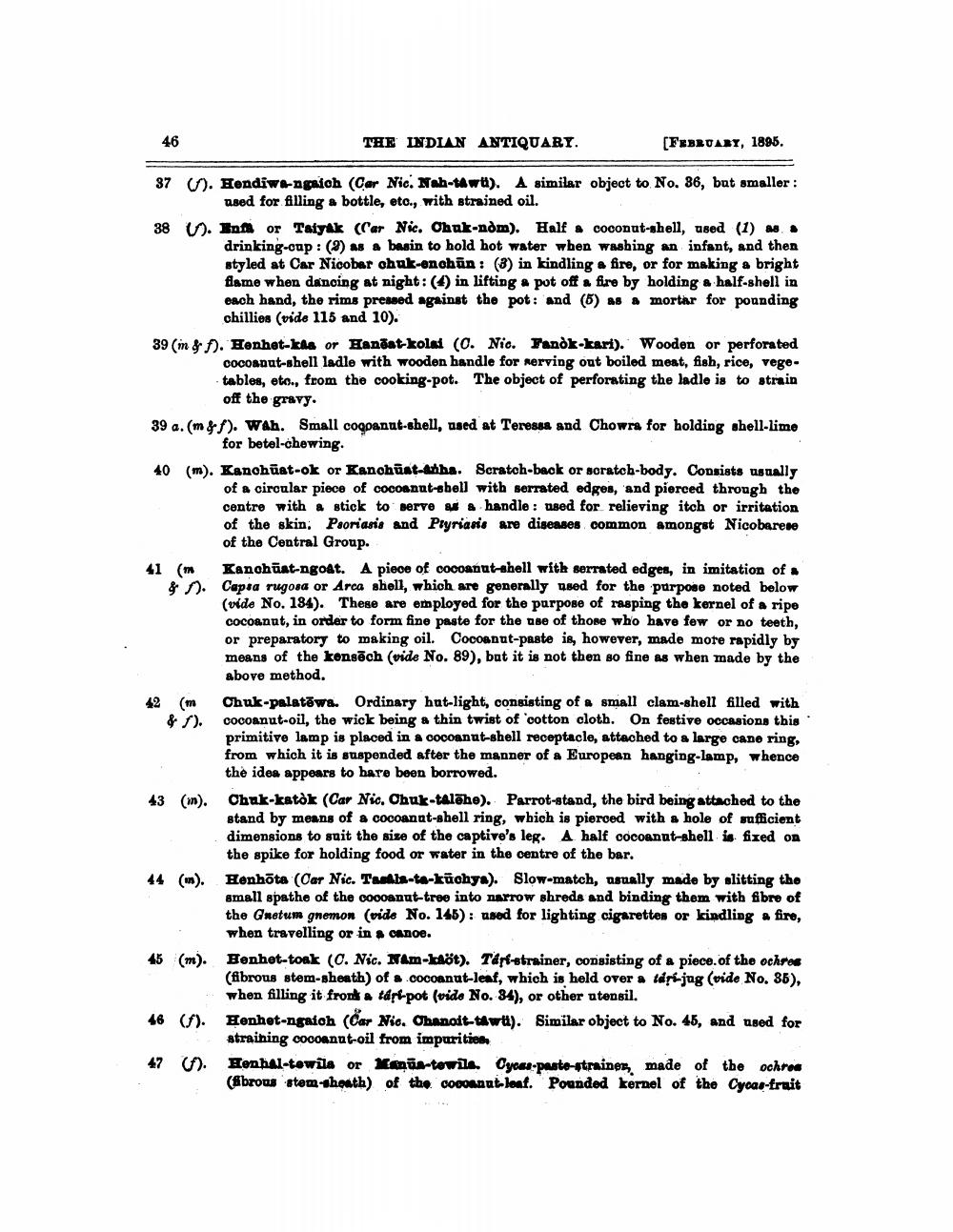________________
46
THE INDIAN ANTIQUARI.
(FEBRUARY, 1895.
37 ). Hendiwe-ngaich (Car Nic. Nah-tawu). A similar object to No. 36, but smaller :
used for filling a bottle, etc., with strained oil. 38 . In or Taiyak (Car Nic. Ohak-ndm). Half a coconut-shell, used (1) as
drinking-cap: (9) as a basin to hold hot water when washing an infant, and then styled at Car Nicobar chuk-onohãn: (3) in kindling a fire, or for making a bright flame when dancing at night: (1) in lifting e pot off a fire by holding a half-shell in each hand, the rims pressed against the pot: and (6) as a mortar for pounding
chillies (vide 115 and 10). 39 (in & ). Eenhet-kha or Hangat-kolai (o. Nic. Tandk-Lari). Wooden or perforated
cocoanut-shell ladle with wooden handle for nerving out boiled meat, fish, rice, vegetables, eto., from the cooking-pot. The object of perforating the ladle is to strain
off the gravy. 39 a. (m8f). Wah. Small coqoanut-shell, ased at Teressa and Chowra for holding shell-lime
for betel-chewing. 40 (m). Kanohüat-ok or Kanohüst-anba. Scratch-back or soratch-body. Consists usually
of a circular piece of cocoannt-sbell with serrated edges, and pierced through the centre with a stick to serve & handle : used for relieving itch or irritation of the skin. Psoriasis and Ptyriasis are diseases common amongst Nicobarene
of the Central Group. 41 m Kanohūst-ngoat. A piece of cocoanut-shell with serrated edges, in imitation of & Capsa rugosa or Arca shell, which are generally used for the purpose noted below
(vide No. 184). These are employed for the purpose of rasping the kernel of a ripe cocoannt, in order to form fine paste for the use of those who have few or no teeth, or preparatory to making oil. Cocoanat-paste is, however, made more rapidly by means of the kensāch (vide No. 89), but it is not then so fine as when made by the above method. Chuk-paletowa. Ordinary hat-light, consisting of a small clam-shell filled with cocoanut-oil, the wick being a thin twist of cotton cloth. On festive occasions this primitive lamp is placed in a cocoanat-shell receptacle, attached to a large cano ring, from which it is suspended after the manner of a European hanging-lamp, whence the idea appears to have been borrowed. Chak-katok (Car Nic, Ohuk-talõhe). Parrot-stand, the bird being attached to the stand by means of a cocoanat-shell ring, which is pieroed with a hole of sufficient dimensions to suit the size of the captive's leg. A half cocoannt-shell is fixed on
the spike for holding food or water in the centre of the bar. 44 (mn). Benhõta (Car Nic. Taas-ta-küchy). Slow-match, usually made by slitting the
small spathe of the coocanut-tree into narrow shreds and binding them with fibre of the Gnetum gnemon (vide No. 146): used for lighting cigarettes or kindling a fire,
when travelling or in a canoe. 45 (m). Benhet-toak (O. Nic. Nam-kaöt). Téri strainer, consisting of a piece of the ochres
(fibrous stem-sheath) of cocoanat-leaf, which is held over a tdph-jag (vide No. 36),
when filling it front a tárf-pot (vide No. 84), or other utensil. 46 (). Henhet-ngaioh (Car Nio. Chanoit-twt). Similar object to No. 45, and used for
straining coconut oil from impurities Een hal-towila or Hea-towile. Cycue-pasto-trainer, made of the ochroe (fibrous stem-shouth) of the cocoanatloaf. Pounded kernel of the Cycas-trait




